The nasal bones are found in the upper middle part of the face. They form the top of the bridge of the nose and determine the size and shape of the nose. These bones are especially sensitive to injuries and fractures.
Record content:
- 1 Location of the bridge of the nose
- 2 The structure and function of the nasal septum
- 3 Signs of curvature
- 4 Causes and types of curvature
-
5 Causes of pain in the bridge of the nose and their additional symptoms
- 5.1 Sinusitis
- 5.2 Ethmoiditis
- 5.3 Vasomotor rhinitis
- 5.4 Ganglioneuritis
- 5.5 Trauma
- 5.6 Charlene's Syndrome
- 5.7 Vegetovascular dystonia
- 6 Doctors treating pain in the bridge of the nose
- 7 Diagnostic methods
-
8 Treatment
- 8.1 Medication
- 8.2 Physiotherapy
- 8.3 Massage
- 8.4 Surgical intervention
- 9 Video about the bridge of the nose
Location of the bridge of the nose
Each person has 2 nasal bones located in the upper middle part of the face, between the frontal processes of the maxillary bones. They are located in the midline, forming the bridge of the nose.
The bones of the nose are usually small and oblong, but they can vary from person to person in size and shape. The function of each nasal bone is to bind together the cartilage that forms the individual contours and shapes of the nose.
The structure and function of the nasal septum
The bridge of the nose is located in the middle zone of the face, where it is formed from 2 thin bones that are connected to each other by a bone suture.

Each consists of 4 bones that form joints:
- 2 cranial;
- 2 facial.
The bones of the skull are called ethmoid and frontal. The facial bones are the upper jaw and the opposite nasal bone.
Each nasal bone has 4 boundaries:
- top;
- bottom;
- lateral;
- medial.
Each nasal bone has 2 surfaces: external and internal. From above, they connect to the frontal bone, forming part of the nasal septum. The bottom edge forms part of the border around the outer opening of the nose. On both sides, the nasal bone is connected by another bone suture with the extension of the upper jaw.
Inside the nose, there is a junction between the nasal septum and the nasal bone. The nasal septum consists in part of cartilage and connective tissue. On the inside, there is a small groove along which the anterior nerve runs.

Ossification of the septum begins at 8 weeks of fetal development in the womb and ends before birth. Hypoplasia or absence of nasal bones is common in Down syndrome (trisomy 21) and other chromosomal abnormalities. For this reason, ultrasound examination of the tip of the nose is part of prenatal screening in many countries.
The function of each nasal bone is to bind together the cartilage that forms the individual contours and shapes of the nose. The bridge of the nose makes a significant contribution to the function of the organ: the inhaled air is heated, cleaned and humidified before reaching the lower respiratory tract.
With the help of the olfactory mucosa, odors can be detected. The nasal cavity and paranasal sinuses are involved as a resonance chamber in the formation of sounds during conversation.
Signs of curvature
The bridge of the nose is located at its apex and is a flat cartilaginous plate that can be damaged, shifted to the left or right. More than 1/3 of the population unknowingly live with a curved septum.
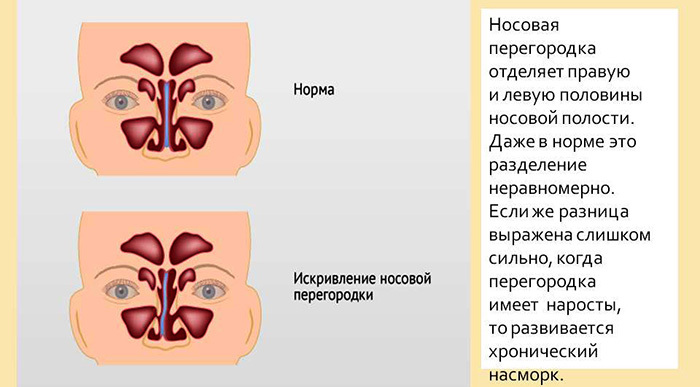
This means that the cartilage dividing the nasal passage is uneven, making one side narrower than the other.
not everyone with a curvature needs correction. Many people have no symptoms of impairment. However, for some, this condition can cause psychological distress or other problems.
Curvature signs:
- Labored breathing. The displacement of the septum makes it difficult for air to pass through half of the nose. This problem is often found with colds or allergies.
- Nasal congestion, headaches. Since air does not always pass freely through the nasal passages, increased pressure is created, causing headaches. Excessive sinus pressure can also cause facial soreness.
- Nosebleeds. A curved septum makes it more difficult for air to pass through the nose. This increases the likelihood of drying out mucous membranes in the nose and frequent nosebleeds.
- Sinus infections. The more clogged your airways, the more likely you are to have sinus infections more often.
- Snore. A deviated septum leads to nasal congestion during sleep, snoring. In rare cases, curvature can contribute to apnea.
Causes and types of curvature
Displacement of the wall to one side leads to the curvature of the septum. In some people, it may be curved or off-center, making one nasal passage smaller. This causes shortness of breath.
Nasal curvatures are divided into groups:
- physiological, associated with the growth and development of cartilage tissue, which is located in the bridge of the nose;
- compensatory, arising from pathologies;
- traumatic.

Possible causes of curvature:
- birth defect;
- bruise, fracture;
- trauma during childbirth;
- polyps and tumors.
The aging process of the body affects the structure of the nose, eventually inspiring the curvature of the septum.
Causes of pain in the bridge of the nose and their additional symptoms
There are many causes of pain in the bridge of the nose. This can be trauma, swelling and infection of the sinus cavities, furunculosis, or perforation of the nasal septum. Although rare, pain in the bridge of the nose can indicate cancer. The mass usually occurs on one side of the nose and can present with facial numbness, headaches, and loss of smell.
Sinusitis
In acute sinusitis, severe pain occurs, and the location of the pain depends on which sinuses are affected by inflammation. If the inflammation is, for example, in the frontal sinus, pain is felt in the forehead.

It is usually unevenly distributed throughout the day, but is felt more strongly in the morning. The pain increases when you touch the wall of the inflamed sinus, for example, with pressure on the forehead.
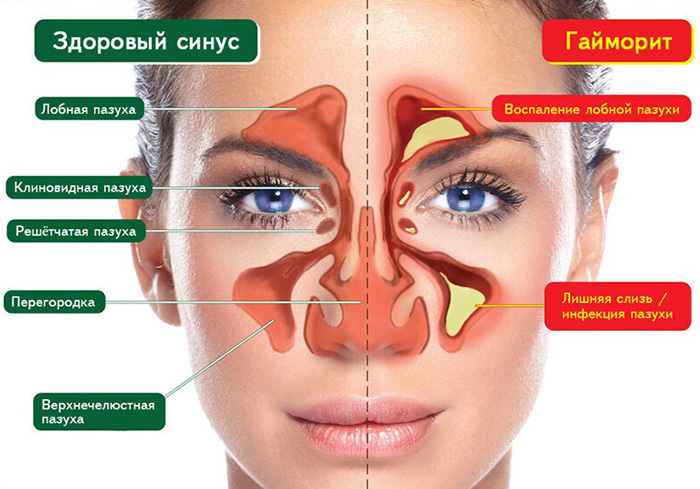
In chronic sinusitis, the syndrome is less severe. However, headaches often occur, which can get worse as the disease worsens.
Ethmoiditis
The bridge of the nose is dangerously close to the brain. Therefore, the inflammation developing in this part can lead to serious consequences.
This refers to ethmoiditis, an inflammatory disease in the ethmoidal sinuses or ethmoidal sinuses. These are air-filled spaces behind the nose and between the eyes. Ethmoiditis is a type of sinusitis resulting from complications of acute respiratory viral infections, influenza.
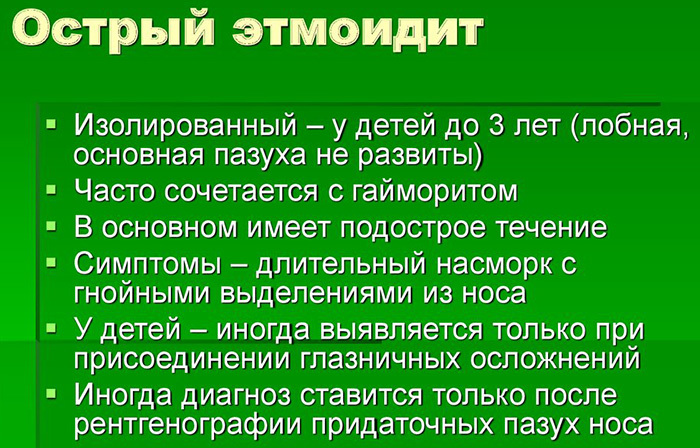
The cause of the development of the disease is bacteria that invade the lattice cells. They cause most sinus infections.
Symptoms usually include:
- headache between the eyes;
- runny nose;
- nasal congestion;
- loss of smell.
Complications after purulent forms of the disease:
- loss of vision;
- orbital abscess;
- redness or abnormal protrusion of the eyes.
Vasomotor rhinitis
Vasomotor rhinitis is a recurrent runny nose or nasal congestion similar to allergic rhinitis, but with no detectable allergic cause. It occurs due to a dysregulation of the blood vessels in the nasal mucosa. WITH
vascular tone is under the control of the autonomic nervous system and depends on how wide or narrow the vessels are, how filled with blood they are. When blood flow increases, the nasal mucosa swells, causing watery puffing and difficulty in nasal breathing.
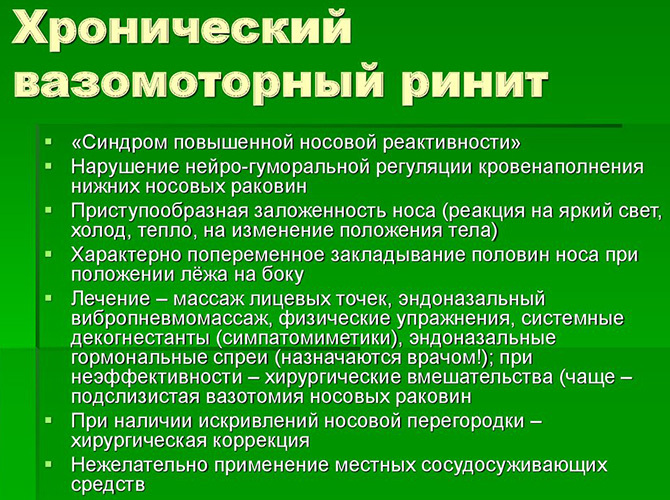
Temperature changes, drinking hot drinks or alcohol, and stress can increase blood flow to the vessels of the nasal mucosa. Overuse of nasal drops and sprays is also a possible trigger.
Irritants such as dry air, smell of fresh paint or solvents can also cause vasomotor rhinitis.
Symptoms and complaints:
- watery nasal mucus, nasal breathing and sneezing;
- loss of smell;
- mild headache.
Ganglioneuritis
Inflammation of the ganglia (grouped as nodes of nerve cells that provide a connection between the peripheral nervous system and the central nervous system) is called ganglioneuritis. It develops as a result of local damage to a bacterial (most often streptococcal or staphylococcal) or viral (adenovirus, herpesvirus) infection.
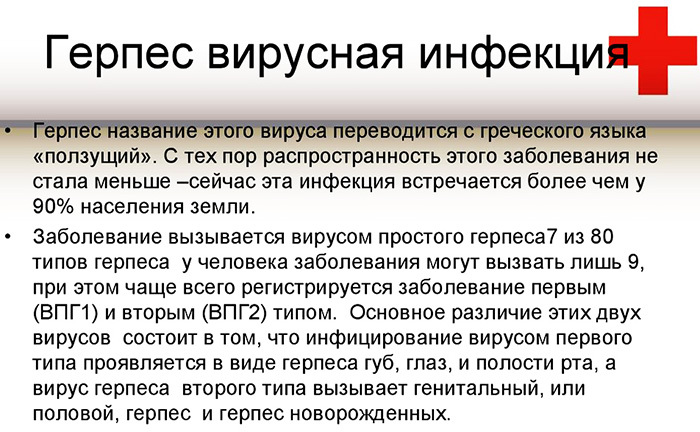
The manifestations of ganglioneuritis depend on the localization of the inflamed ganglion, but the first signs of pathology are neuralgic pain.
The following symptoms indicate pterygoid ganglionitis of the vascular nodule:
- sudden attacks of severe pain, involving the area of the eye (with its redness), nose, jaw, temples, ears;
- painful attacks in the shoulder blades;
- pain in the upper limbs.
The pain appears against the background:
- unilateral hyperemia and edema of the skin of the facial part of the skull;
- increased sweating;
- photophobia;
- sneezing;
- increased release of lacrimal fluid.
Nausea and dizziness are common.
Trauma
The nose is extremely prone to fractures, for example from sports injuries, traffic accidents, severe bruises. Possible open or closed fracture. An open nasal fracture is easy to recognize: the skin around the nose is torn, and fragments of bone are visible. With a closed fracture, the integrity of the skin is not compromised.

Just a swelling doesn't mean the nose is broken. Symptoms such as swelling and bruising may appear several hours after the injury. With a fracture, swelling of the nasal septum occurs due to bleeding, as a result, nasal breathing is difficult or even impossible.
A possible complication is septal necrosis. The cartilage is no longer supplied with enough blood and the tissue dies. Bacterial infection of the septal hematoma is also possible.
This can lead to:
- abscess;
- accumulation of pus;
- a hole in the nasal septum (septum perforation).
Charlene's Syndrome
In the case of neuralgic diseases, there are sharp paroxysmal pains at night. In the bridge of the nose, they are more common in young and middle-aged people. This can be, for example, nasal nerve neuralgia, which is called Charlin's syndrome.
The disease develops as a result of:
- inflammation in the sinuses;
- various infections;
- curvature of the nasal septum;
- dental diseases.
With neuralgia of the nasal nerve, paroxysmal pains are quite long and intense. To relieve pain, pain relievers are used, solutions in the form of eye drops.

There may be problems with the nutrition of the cornea, and it may be necessary to treat not only a neurologist, but also an ophthalmologist. Neuralgia may appear without additional symptoms.
In severe cases, during an attack begins:
- runny nose;
- throbbing in the forehead;
- swelling of the mucous membrane in the nose;
- redness of the eyeballs;
- lacrimation.
Pulsation in the frontal zone can be felt as pain during moments of rest.
Vegetovascular dystonia
Vegetovascular dystonia is a painful condition in which a disturbance in the vascular system of the body leads to an insufficient supply of oxygen to the tissues.
The disorder is also known by the names:
- neurodystonia;
- autonomic dysfunction;
- cardiac neurosis;
- functional cardiomyopathy.
Vegetovascular dystonia is not a single whole, but a collection of different conditions that together cause certain symptoms. The disorder can be caused by alcohol abuse, infections, or stress.
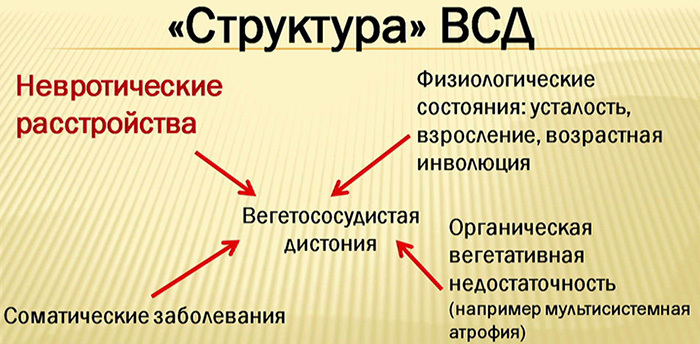
Under the influence of neurogenic factors, vasoconstriction occurs, which leads to vasomotor rhinitis.
Symptoms:
- difficulty in nasal breathing;
- dry and itchy nose;
- discharge from the nose;
- violation of the sense of smell.
All this is complemented by general weakness, increased fatigue, memory impairment, headache, sleep disturbances, and loss of appetite.
Doctors treating pain in the bridge of the nose
Nasal pain in the bridge of the nose is examined and treated by an otolaryngologist. Based on the results of the examination, the doctor can refer you to other specialists for treatment.
Trauma surgeons are often referred to with nasal injuries. If there was no damage, and the pain in the bridge of the nose was not accompanied by a runny nose or acute respiratory infections, it is worth contacting a neurologist. It is this specialist who can identify Slader's or Charlene's syndrome.
If the bridge of the nose hurts for more than 3 days, you need to seek help.
Diagnostic methods
Anyone who has the feeling that he cannot breathe enough air through his nose, even if he has not caught a cold, should be examined by a doctor.

Doctors use special examination devices to check for nasal permeability:
- Rhinoscopy. During the diagnosis, the inside of the nose is examined. To do this, the doctor uses rigid and flexible endoscopes and examines the cartilaginous and bony passages of the nasal septum.
- Spirometry. At the same time, it measures air resistance during inhalation and exhalation using a breathing mask and a digital receiver. This nasal resistance serves as a parameter for nasal permeability. Thus, the curvature is determined, leading to impaired breathing.
- X-ray and computed tomography. A fracture, compression, or displacement of cartilage and bony structures can be seen on x-rays or CT scans.
Treatment
Initial treatment for a deviated septum may be aimed at relieving symptoms.
Medication
In the case of a slight curvature of the nasal septum, as well as in the case of allergies and frequent colds due to a narrow nasal cavity you can turn to drug therapy:
| Group of drugs | Name | Characteristic |
| Decongestants | Naphazoline Tetrizoline Astemizole |
Drugs in this group reduce swelling of the tissues of the nose and help keep the airways on both sides of the nose open. The funds are available in the form of tablets or nasal spray. Frequent and prolonged use of the nasal spray can be addictive and worsen symptoms. |
| Antihistamines | Afrin Citrine Loratadin |
Medicines in this group can help prevent allergy symptoms, including nasal congestion or runny nose. They can sometimes help with non-allergic conditions such as colds. |
| Nasal steroid sprays | Fliksonase Avamis Tafen Nazal |
Corticosteroid nasal sprays reduce swelling in the nasal passage and help with drainage. It usually takes 1 to 3 weeks to achieve maximum effect, so it is important to follow your doctor's instructions when using them. |
Treatment for pain caused by neuralgia is carried out with the help of anticonvulsants: carbamazepine and gabapentin. High doses of steroids and anesthetics are also used.
Physiotherapy
The bridge of the nose is in close proximity to the frontal bone, so the disorder often causes headaches. The physical therapist has many treatment options, the forms of which depend on the type of disease.

Doctors conduct:
- inhalation;
- laser, ultrasound therapy;
- shortwave diathermy;
- high frequency currents;
- UFO.
Massage
Massage helps to remove mucus from the sinuses and relieve nasal congestion. The pain is relieved much faster by acupressure.
You can massage only those sinuses that bother you, or all at once:
- ethmoid sinuses, located on each side of the bridge of the nose;
- maxillary, located on each side of the nose, next to the cheeks;
- frontal, located above the eyes near the forehead.
Surgical intervention
Severely deviated nasal septa cannot be effectively treated with drugs; they are treated with surgery.

During septoplasty (surgery to correct the nasal septum), the bone and cartilaginous parts are straightened as needed, or small pieces of bone or cartilage are removed. This is not done to restore the shape of the nose, but to improve nasal breathing.
Pain in the nose, bridge of the nose, and nasal diseases are not always harmless and can have serious consequences, especially if the inflammation spreads to the eyes or brain. You should not neglect the symptoms, but it is better to undergo an examination and find the place where the inflammation is located.
Video about the bridge of the nose
Diagnosis and treatment of curvature of the nose bridge:



